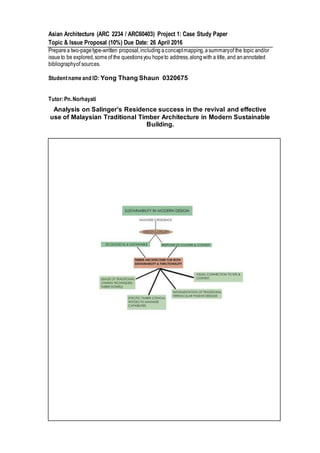Shauns aa
- 1. Asian Architecture (ARC 2234 / ARC60403) Project 1: Case Study Paper Topic & Issue Proposal (10%) Due Date: 26 April 2016 Preparea two-pagetype-written proposal,including aconceptmapping,asummaryof the topic and/or issueto be explored,someof the questionsyou hopeto address,alongwith a title, and anannotated bibliographyof sources. Studentname and ID: Yong Thang Shaun 0320675 Tutor:Pn.Norhayati Analysis on Salingerâs Residence success in the revival and effective use of Malaysian Traditional Timber Architecture in Modern Sustainable Building.
- 2. Research Question(s): 1. How did thearchitectsuccessfullyimplementtraditional timberarchitectureinto Salingerâs Residencewhileeffectively contributeto thebuildingssustainability? 2. To what extent isa building considered sustainableandhowdoestimberplayapartin that? 3. How doesSalingerâsResidenceuseoftraditionaltimberarchitecturedifferfromothersimilar yet notas effectivebuildings? Research Objective: 1. To revivetheuseof traditionaltimberarchitecturein currentmodern building designs 2. To studythevariouseffectiveuseoftimberin aquestofachieving sustainability Summary ofthetopic (277words): Throughtheages,Malaysianâsstyle of timberarchitecturehasbeenslowlyburiedawayby time.The onceprominentimageofMalaysiaâsstyle was famedfor its design sensitivity to context andits friendly minimal impactontheenvironment(LilawatiAb Wahab , 2005).However, with the presenceofnew materialssuchasconcreteandmetal,thetraditionaltimberstyle architectureisless seeneven though other materialsrequirehigherenergyto produceandalsohave significantcarbonfootprints.Dueto Malaysiaâscurrentclimate,sustainablebuildingdesignsshouldbeconsideredwherenotonlythe materialbutalso the structureitself wouldworkhand inhandwith the environmentwithoutseverely affectingit (A.S. Hassan, 2001).Thebuildingchosentofurther bringemphasistothis subjectis SalingerâsResidencebyJimmyC.S Lim.Thearchitecthadmanagedtorevive Malaysian traditional timberarchitecture;notonlywas it implemented asaesthetics,italso further contributesto the sustainabilityof the building.Inthis paper, the SalingerâsResidenceâsrevivalandeffective useof Malaysiantraditionaltimberarchitectureinmoderndaysustainablebuildingswillbeanalyzed to encouragefuturebuildingdesignsmakinguseoftraditionalstyles. Thispaperwillnot onlyexplorethe sustainabilityof the traditionalstyle but also its functionalityand aesthetics.Thefocuswillbeonthe successfulimplementationoftraditionalvernacularpassivedesigns usedin the building,the characteristicsandcapabilitiesofthe materialitselfand alsothe traditionaluseof joiningtechniquesin the structure. Throughthisanalysis,we willhave a deeperunderstandingandappreciationforthe Malaysiantraditionaltimberarchitectural styleandhopefullyrevive suchstyle in future modernbuildings as to not onlypromotesustainabilitybut to also have an originalidentity.
- 3. Annotated Bibliography A.S. Hassan (2001). Towards Sustainable Housing Construction in Southeast Asia. Journal of Agenda 21 for SustainableConstructioninDevelopingCountries,FirstDiscussionDocument. Rotterdam,Netherland. Discussesthe climate characteristicsof Asian countriesandalso feasiblesustainablesolutionstothem. LilawatiA.W., Kamarul S.K., Husrul N.H., Mohd Azian Z. (2005). Architectural Design of Traditional Malay House.ProceedingsofInternationalSeminarMalayArchitectureasLinguaFranca (2005).Jakarta Indonesia. The book definesandanalyzesMalaysianvernacularhousesandthe evolutionit goesthrough whether cultural,socioeconomic,religionorenvironmentalneedsthatcould influenceitsdesign. Nasir, A.H. (1985)IntroductionofTraditional MalayHouse:PeninsularMalaysiaDarulfikir:Kuala Lumpur. Providesan introductionto passivedesignsfoundin traditionalmalayhouseswhich includesventilation, sun shading,vegetationandbuildingmaterial. SalingerResidenceOn-siteReviewReport,edited by Aga Khan Award for Architecture,1998. The report covers the background,context, conceptand the entireproject of the SalingerâsResidence by Jimmy C.S Lim


